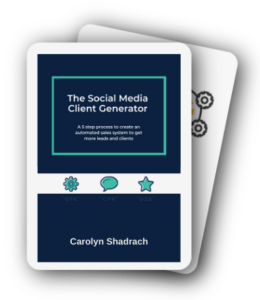Psychology has a lot to teach us about marketing.
That only makes sense, as successful marketing of your products or services really boils down to a very simple, all-too-human act: the act of persuading a person to move from one state (not-a-client) to another (client).
That movement is called a “conversion” in online marketing. In any kind of marketing, it’s called a sale! And psychology can help you increase yours.
Here are four psychological principles that play a big role in making the sale.

Principle #1: The Fear of Being Left Out
What It Is: People are afraid, to varying degrees, of being left out or of not fitting in where they perceive themselves as “belonging.”
What It Means: If you can persuade your prospects through your copy and design elements that they belong in your “tribe,” or circle, they’re more likely to convert to a subscriber or paid client/customer.
How to Use It: Look for ways to establish social proof in your online marketing. Facebook elements such as the number of likes (and especially the identity of those “likes” when your prospect is connected to them) are a powerful way to accomplish this.
Similarly, think of ways to distinguish your prospects from the “average” person—i.e., the person who isn’t your prospect. Copy such as “for serious entrepreneurs only” or even something as simple as “this isn’t for everyone” can help your prospect identify with your brand and offer more strongly because of a desire to become part of the “inner circle.”
Principle #2: The Aversion to Loss
What It Is: People hate missing out. FOMO. Fear of missing out. (Yes, it’s that simple.)
What It Means: If you can convince your prospects that there’s a chance they may not obtain a specific benefit, they’ll be more likely to take action to prevent that from happening.
How to Use It: The factors of urgency and scarcity are your main tools in implementing this particular principle. But be careful here, for it’s all too easy to use these tools indiscriminately and actually lose conversions. If there really is an actual deadline in place—for instance, tickets to a live event have a built-in urgency factor the closer the date for the event looms—then by all means, let your prospects know. And if you really do have a limited number of products or spots available—for instance, where you’re teaching a class with space for ten students, but only ten, because of a built-in coaching component—then mention that, too.
But creating fake or artificial urgency or scarcity will likely backfire. Your prospects are savvier than they used to be, and they may very well see through such tactics, as they may have been overused and misused in the past by other marketers.
Principle #3: The Anchoring Tendency
What It Is: People tend to compare even dissimilar solutions or options against the solution/option that came first—or the one they perceive as having come first.
What It Means: Your prospects will be in a constant state of “comparison shopping,” and sometimes you have no idea where you are in that process. Help your prospects “anchor” to your offer more strongly.
How to Use It: Differentiation is key here, as is a strong sense of your offer’s benefits. You want to show how you are first-of-its-kind. Don’t hesitate to point out discounts, bonus materials, and other features that distinguish your offer from others. You can apply this idea whether you are asking for a sale, a Facebook like, a tweet on Twitter, or an email sign-up.
Principle #4: The Foot-in-the-Door Factor
What It Is: People are more likely to say “yes” to a large request after they’ve already agreed to a smaller one.
What It Means: You can prime your prospects—carefully!—and increase your conversion rate.
How to Use It: Carefully plan each prospect’s path along your marketing funnel online. Once they’ve said “yes” to a small action—say, reading a blog post—make a second larger request (perhaps signing up for your email newsletter).
You may unwittingly be leveraging some of these principles in your marketing already, but the more you understand how these principles work, the more intentional and effective your marketing can become.
A great book on human behavior for any marketer is “Influence” by Robert Cialdini, a must-read if you want to understand the power of leaning into psychological triggers.

